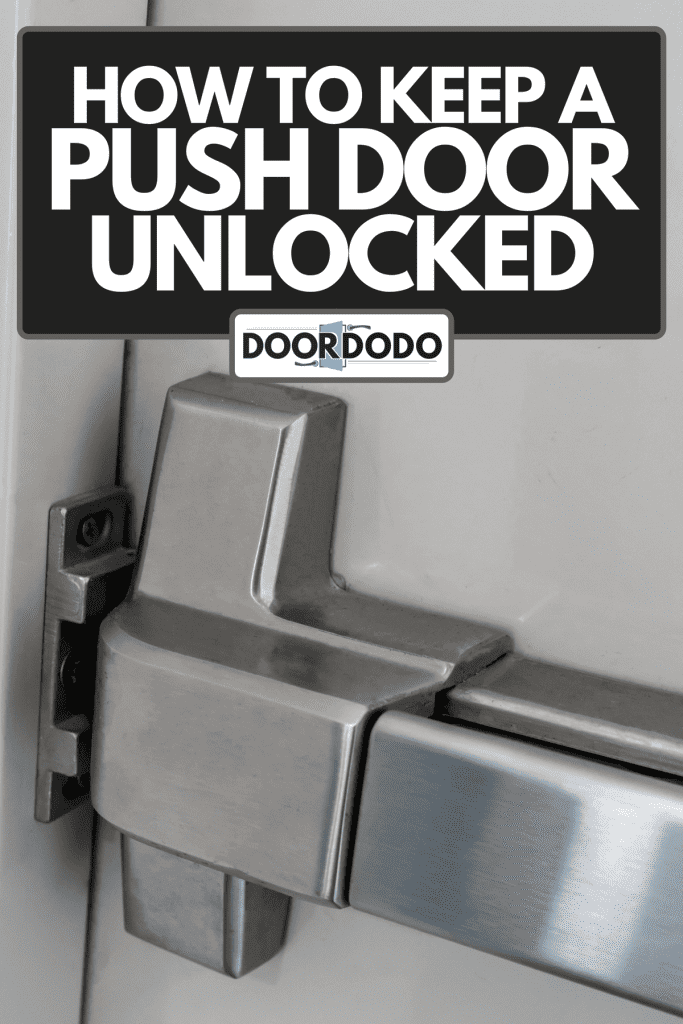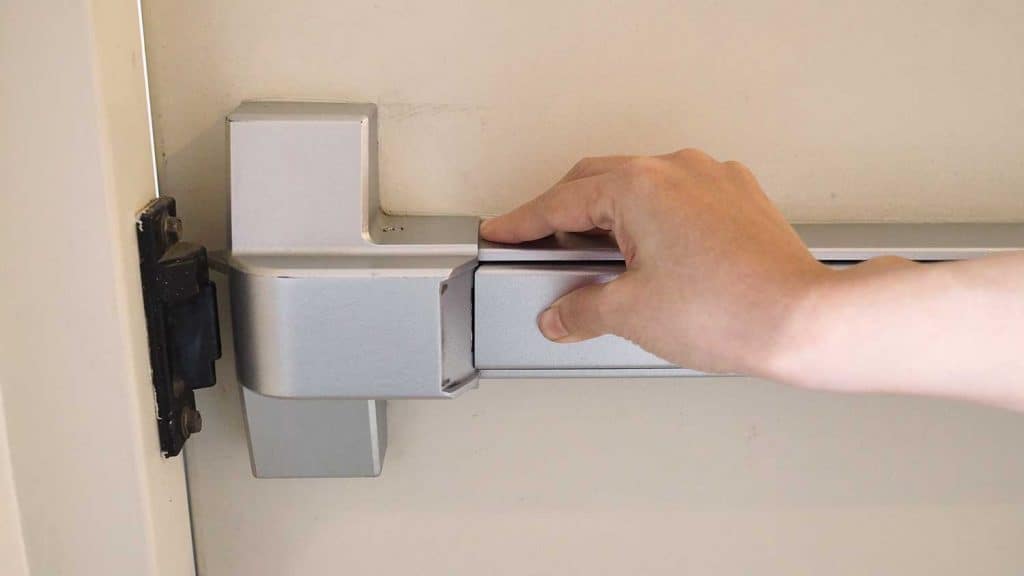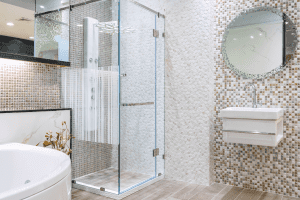Push doors should remain unlocked at all times to facilitate seamless exit from a place without having a door in the way. But how can you keep this door unlocked? We researched the topic, and this is what we found out.
The brand and model of a push door determine how you can keep this door unlocked. To keep the door unlocked in most cases, you will need to follow these basic steps:
- Find the hexagonal key that is specific to your door brand and model
- Locate the hole in the interior bar of the push door
- Insert and turn the hexagonal key anticlockwise.
Some door models use a regular key in place of the hexagonal key, while others keep the door unlocked by turning the key on the outer opening and pressing the exit bar down.
Now that you understand how to keep a push door unlocked, it is equally important to know how door push bars work. Keep reading to find out what a panic bar on the door is, how to disable automatic locking doors, and how to lock a push bar.

How do you lock and unlock a push bar door?
Push bars are door opening mechanisms found on the inner side of emergency exit doors. They enable the timely exit of the occupants of a building in case of an emergency. Although they should be kept open to facilitate easy exit, you may want to lock the door after business hours to secure your building.
Locking or unlocking a push bar door largely depends on its type. While most doors use a hex key, some use a standard key to fasten the bar in place.
Watch the video above for a visual guide or follow these simple steps to lock or unlock your push bar door using a hex key.
Take note that you will need a hexagonal key that is suitable for your door model.
Check out this hex dogging key on Amazon.
To unlock the door, carefully do the following:
- Press and hold the push bar in.
- Locate the hole in the inner side of the bar.
- Insert the hex key.
- Twirl the key until you hear a click sound.
To lock the door, turn the key in the opposite direction.
It is prudent to check the door manufacturer's instructions on how to lock or unlock the door since some doors may be opened by turning the key on the exterior opening and pushing the exit bar down.
How do door push bars work?

Door push bars are designed to enable fast and uninhibited exit from an egress. They are generally installed in high traffic areas such as movie theaters and restaurants and in hallways where fire regulations stipulate compartmentalization and separation of spaces to control smoke, heat, or fire.
Older models of door push bars use a horizontal pipe or flat bar attached to the door. The door has a pair of handles that swivel on the base plates on each side of the bar or pipe.
These handles activate a latch retractor mechanism when pushed, enabling the door to function efficiently. It's important to note that these doors have to be appropriately maintained for them to serve you befittingly.
More recent models have a crash bar in place of the bar or pipe in the earlier makes. Although both models are similar in operation, the newer models improve on the shortcomings of the preceding make by ensuring that the crash bar performs with lesser movable components on the exterior of the device.
As a result, the crash bar is easier to push and is more resistant to obstructive issues.
The door push bars should have these qualities:
- Simple to use in that no special knowledge is required to operate them.
- Allow exit without the use of a key.
- User friendly for handicapped and able-bodied individuals.
Maintenance Of Door Push Bars
Poor maintenance and incorrect installation of door push bars may endanger the safety of a building's users. You should therefore take care to ensure that the door push bars function optimally by carrying out these steps:
- Regularly check whether the push bars are functioning optimally. Inspect whether the locking points disengage when the bar is pushed and whether the latch holds as the door closes.
- Confirm that the operating force required to activate the unlocking mechanism is maintained below 15 pounds.
- Ensure that no additional latching devices have been added to the door.
- Regularly clean the movable components as dirt would alter optimal functioning.
- Lubricate all movable parts as per the manufacturer's guidelines.
- Ensure that all parts are carefully secured.
- Apply an appropriate thread lock as appropriate.
How do you disable automatic locking doors?
Automatic locking doors are advantageous because they enhance security and convenience since the lock activates immediately upon closing. Additionally, you can remotely control the entry points.
However, you may need to disable the automatic locking doors if you have guests who are not familiar with the technology in place or they may have internet or electricity connection challenges.
Automatic locking doors have a small motor within the door or frame controlled by an electric impulse. Although a keypad, a wireless remote control sensor, or an electronic card reader may trigger the motor, most automatic locking doors have a physical key set up and emergency backup.
To disable the automatic door, turn the key all the way clockwise or anticlockwise and then come back to the center.
What is panic bar on door?

A panic bar on the door is a simple device that facilitates the easy exit of the occupants of a building in case of an emergency. These bars are located on the inner side of an egress that opens outwards in the direction that people are exiting.
Because the doors open easily, these bars also minimize the risk of being trampled over as people flee for safety.
The mechanism on panic doors rapidly engages when slight pressure is applied on the bar, allowing operation from the inside while preventing access from the outside. Therefore, while people can quickly exit a building in case of danger, they cannot run in the direction of danger.
Besides their primary role in enabling uncomplicated departure, panic bars may also bring these benefits:
- They prevent access from intruders who may attempt to force their way in.
- The bars can be used alongside alarms to notify security personnel when an emergency exit is breached or if a controlled area is accessed.
The requirements for where panic bars should be installed vary from place to place. You should therefore consult your local building codes to ensure compliance. Moreover, you can still install these bars for convenience and security even if your building does not fall in the specified category.
For regions that have adopted the International Building Code, panic bars should be installed in appropriate places which include:
- Assembly buildings with a capacity of 50 people or more
- Educational institutions with a capacity of 50 people or more
- All high hazard areas such as battery rooms, areas where equipment has more than 600V and control rooms where overcurrent and switching devices are located.
These regulations only apply to doors that lock or latch.
Final Thoughts
You should keep a push door unlocked as this would save lives in the event of an emergency. However, if you need to lock or unlock the door, we hope the information in this article will enable you to do that. Further, ensure that you regularly maintain your door hardware to keep it in proper working condition.
Before you go, look into these articles to find out why push doors have handles and turn off door chimes:




